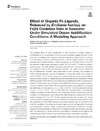Identificador persistente para citar o vincular este elemento:
https://accedacris.ulpgc.es/jspui/handle/10553/41869
| Campo DC | Valor | idioma |
|---|---|---|
| dc.contributor.author | Samperio-Ramos, Guillermo | en_US |
| dc.contributor.author | Santana-Casiano, J. Magdalena | en_US |
| dc.contributor.author | González-Dávila, Melchor | en_US |
| dc.date.accessioned | 2018-09-06T08:13:23Z | - |
| dc.date.available | 2018-09-06T08:13:23Z | - |
| dc.date.issued | 2018 | en_US |
| dc.identifier.issn | 2296-7745 | en_US |
| dc.identifier.other | WoS | - |
| dc.identifier.uri | https://accedacris.ulpgc.es/handle/10553/41869 | - |
| dc.description.abstract | The potential effect of ocean acidification on the exudation of organic matter by phytoplankton and, consequently, on the iron redox chemistry is largely unknown. In this study, the coccolithophorid Emiliania huxleyi was exposed to different pCO2conditions (225-900 μatm), in order to determine the role of natural organic ligands on the Fe(II) oxidation rate. Oxidation kinetics of Fe(II) were studied as a function of pH (7.75-8.25) and dissolved organic carbon levels produced (0-141.11 μmol C L-1) during the different growth stages. The Fe(II) oxidation rate always decreased in the presence of exudates as compared to that in the exudates-free seawater. The organic ligands present in the coccolithophorid exudates were responsible for this decrease. The oxidation of Fe(II) in artificial seawater was also investigated at nanomolar levels over a range of pH (7.75-8.25) at 25°C in the presence of different glucuronic acid concentrations. Dissolved uronic acids (DUA) slightly increased the experimental rate compared to control artificial seawater (ASW) which can be ascribed to the stabilization of the oxidized form by chelation. This behavior was a function of the Fe(II):DUA ratio and was a pH dependent process. A kinetic model in ASW, with a single organic ligand, was applied for computing the equilibrium constant (log KFeCHO+= 3.68 ± 0.81 M-1) and the oxidation rate (log kFeCHO+= 3.28 ± 0.41 M-1min-1) for the Fe(II)-DUA complex (FeCHO+), providing an excellent description of data obtained over a wide range of DUA concentrations and pH conditions. Considering the Marcus theory the Fe(III) complexing constant with DUA was limited to between 1013and 1016. For the seawater enriched with exudates of E. huxleyi a second kinetic modeling approach was carried out for fitting the Fe(II) speciation, and the contribution of each Fe(II) species to the overall oxidation rate as a function of the pH/pCO2conditions. The influence of organic ligands in the Fe(II) speciation diminished as pH decreased in solution. During the stationary growth phase, the FeCHO+complex became the most important contributor to the overall oxidation rate when pH was lower than 7.95. Because CO2levels modify the composition of excreted organic ligands, the redox behavior of Fe in solution may be affected by future acidification conditions. | en_US |
| dc.language | eng | en_US |
| dc.relation.ispartof | Frontiers in Marine Science | en_US |
| dc.source | Frontiers in Marine Science [ISSN 2296-7745], v. 5 (210) | en_US |
| dc.subject | 251002 Oceanografía química | en_US |
| dc.subject.other | Emiliania huxleyi | en_US |
| dc.subject.other | Ocean acidification | en_US |
| dc.subject.other | Fe(II) oxidation | en_US |
| dc.subject.other | Exudates | en_US |
| dc.subject.other | Uronic acids | en_US |
| dc.subject.other | Organic ligands | en_US |
| dc.subject.other | Redox behavior | en_US |
| dc.subject.other | PH | en_US |
| dc.title | Effect of organic Fe-ligands, released by Emiliania huxleyi, on Fe(II) oxidation rate in seawater under simulated ocean acidification conditions: A modeling approach | en_US |
| dc.type | info:eu-repo/semantics/Article | en_US |
| dc.type | Article | en_US |
| dc.identifier.doi | 10.3389/fmars.2018.00210 | en_US |
| dc.identifier.scopus | 85048619431 | - |
| dc.identifier.isi | 000457164400001 | - |
| dc.contributor.authorscopusid | 56642842400 | - |
| dc.contributor.authorscopusid | 6701344294 | - |
| dc.contributor.authorscopusid | 6603931257 | - |
| dc.identifier.eissn | 2296-7745 | - |
| dc.identifier.issue | 210 | - |
| dc.relation.volume | 5 | en_US |
| dc.investigacion | Ciencias | en_US |
| dc.type2 | Artículo | en_US |
| dc.contributor.daisngid | 6991629 | - |
| dc.contributor.daisngid | 579253 | - |
| dc.contributor.daisngid | 518149 | - |
| dc.description.numberofpages | 16 | en_US |
| dc.utils.revision | Sí | en_US |
| dc.contributor.wosstandard | WOS:Samperio-Ramos, G | - |
| dc.contributor.wosstandard | WOS:Santana-Casiano, JM | - |
| dc.contributor.wosstandard | WOS:Gonzalez-Davila, M | - |
| dc.date.coverdate | Junio 2018 | en_US |
| dc.identifier.ulpgc | Sí | es |
| dc.description.sjr | 1,367 | |
| dc.description.jcr | 3,086 | |
| dc.description.sjrq | Q1 | |
| dc.description.jcrq | Q1 | |
| dc.description.scie | SCIE | |
| item.fulltext | Con texto completo | - |
| item.grantfulltext | open | - |
| crisitem.author.dept | GIR IOCAG: Química Marina | - |
| crisitem.author.dept | IU de Oceanografía y Cambio Global | - |
| crisitem.author.dept | Departamento de Química | - |
| crisitem.author.dept | GIR IOCAG: Química Marina | - |
| crisitem.author.dept | IU de Oceanografía y Cambio Global | - |
| crisitem.author.dept | Departamento de Química | - |
| crisitem.author.orcid | 0000-0002-7930-7683 | - |
| crisitem.author.orcid | 0000-0003-3230-8985 | - |
| crisitem.author.parentorg | IU de Oceanografía y Cambio Global | - |
| crisitem.author.parentorg | IU de Oceanografía y Cambio Global | - |
| crisitem.author.fullName | Santana Casiano, Juana Magdalena | - |
| crisitem.author.fullName | González Dávila, Melchor | - |
| Colección: | Artículos | |
Los elementos en ULPGC accedaCRIS están protegidos por derechos de autor con todos los derechos reservados, a menos que se indique lo contrario.
